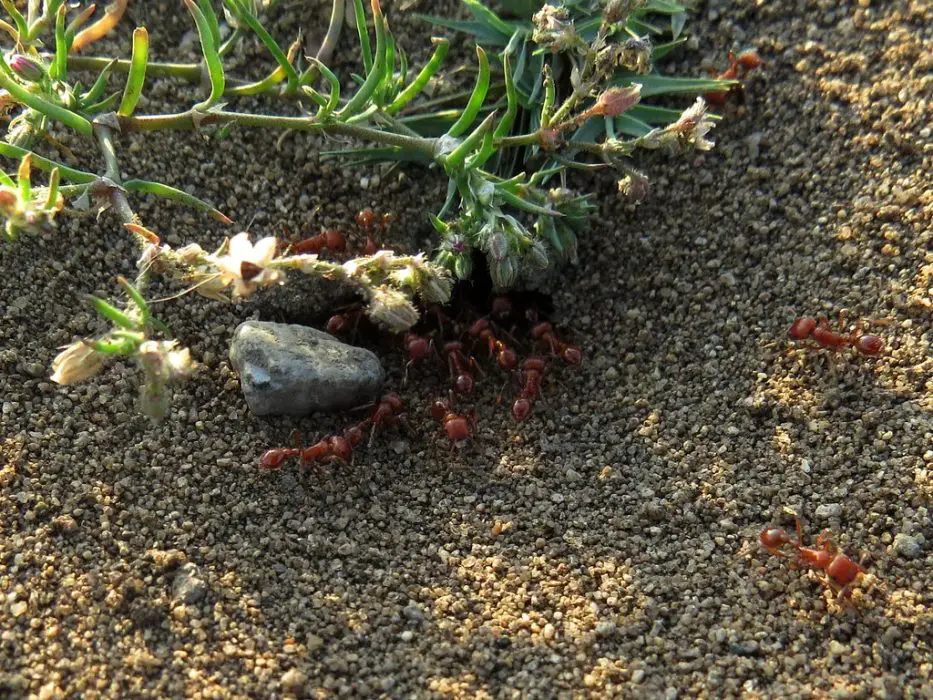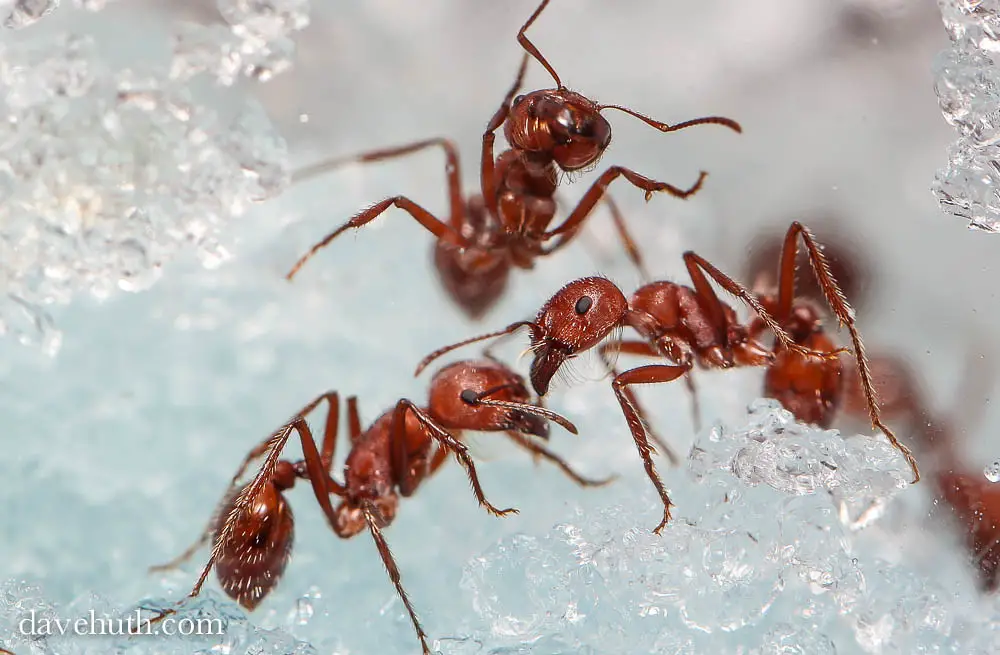Beneath our feet lies a captivating world, where red harvester ants, small yet tenacious, meticulously craft intricate tunnels and chambers. Even more astonishing, they thrive in arid deserts, enduring scorching heat while acquiring sustenance where it seems impossible.
These ants actively gather seeds, insects, and nectar with unmatched diligence and teamwork. They fiercely protect their reserves, employ sentinels stationed at tunnel entrances, and effectively communicate to ward off intruders.
Moreover, red harvester ants offer valuable lessons in cooperation and resourcefulness, inspiring us to embrace teamwork and sustainability in our own lives.
So, the next time you encounter these ants on your outdoor adventure, remember the intricate world below. It’s a testament to nature’s beauty, offering insights into harmonious coexistence with the environment.
Red harvester ants actively showcase the rich complexity of life on our planet, inviting us to appreciate and learn from their remarkable strategies.
What do Red Harvester Ants Look Like?
Red harvester ants (Pogonomyrmex barbatus), as their name suggests, have distinctive features that make them easily recognizable.
Here’s a description of what they look like:
- Coloration: They are typically reddish-brown to dark reddish-brown in color. Their bodies have a reddish hue, especially on the head and thorax, while the abdomen may appear darker.
- Size: These ants are relatively large compared to other ant species. Worker ants can range from 1/4 to 3/8 of an inch (6 to 10 millimeters) in length, with queens being even larger.
- Body Shape: They have a robust and sturdy build. Their bodies are divided into three distinct segments: head, thorax, and abdomen.
- Head: The head of a red harvester ant is square-shaped when viewed from above. They have large, powerful mandibles (jaw-like structures) that they use for digging and carrying food.
- Eyes: They have well-developed eyes, which are relatively large and located on the sides of their heads. This is in contrast to some ant species with reduced or no eyes.
- Stinger: These ants possess a stinger at the tip of their abdomen, which they use for defense against predators and to subdue prey.
- Hair: Red harvester ants may appear slightly hairy, with fine, short hairs covering their bodies.
Red Harvester Ant Queen
The Red Harvester Ant queen, larger than worker ants, is the colony’s sole egg layer, playing a pivotal role in reproduction. Her leadership and longevity ensure colony growth and sustainability, making her a vital asset within the colony.
What Do Red Harvester Ants Eat?
Red Harvester Ants are primarily herbivorous and have a distinctive diet focused on seeds.
Let’s delve deeper into the diet of these Ants:
- Seed Predation: These Ants specialize in predating seeds, actively seeking, collecting, and processing various seeds, including those from grasses and local plants.
- Seed Collection and Storage: Foraging workers actively clip seeds from plants using their powerful mandibles and then transport them to underground chambers, meticulously storing them to shield them from environmental factors and potential predators.
- Seed Preparation and Balanced Diet: Before consumption, ants actively remove the outer seed coatings through winnowing, ensuring they access the nutrient-rich interior. Additionally, they actively supplement their diet with nectar and insects whenever these food sources become available, maintaining a well-rounded nutritional intake.
- Importance of Seeds: Seeds assume critical importance as a long-term food supply for Red Harvester Ant colonies, particularly in arid environments. The ants actively ensure their survival by efficiently collecting, processing, and storing seeds.
Where Do Red Harvester Ants Live?

Ever wondered where these tiny but tenacious Red Harvester Ants call home? They thrive in arid North American landscapes, but what are the specifics?
- Preferred Habitat: They commonly inhabit arid and semi-arid regions in North America.
- Sunny Environments: They favor sunlit areas, including deserts, grasslands, and scrublands.
- Underground Nests: These ants actively construct elaborate underground nests, marked by conspicuous mounds of excavated soil.
- Adaptation to Dry Soil: Thriving in dry, sandy, or rocky soils, they efficiently forage for seeds and maintain their colonies.
- Specialists in Arid Climates: They excel in arid conditions, establishing a significant presence throughout North America’s challenging arid environments.
Red Harvester Ant Bite:
Have you ever wondered about the bite of a Red Harvester Ant?
Let’s dive into the details:
- Painful Stings: They are potent stingers and deliver painful, burning stings when they bite causing discomfort that lasts for hours.
- Allergic Reactions: While their bites are generally not life-threatening, some individuals may experience allergic reactions, making it crucial to be cautious.
- Self-Defense: These ants primarily bite when they feel threatened or their nest is disturbed.
Red Harvester Ants Control
Dealing with Red Harvester Ants in your space? Here’s how to control them effectively:
- Identification: First, accurately identify them to ensure you’re dealing with the right species. They are typically reddish-brown and larger than many other ants.
- Sanitation: Maintaining a clean environment is crucial. They are attracted to food sources, so ensure that all food residues are cleaned up promptly. Seal food containers and clean up spills.
- Baits: Consider using ant baits designed specifically for these Ants. These baits contain slow-acting insecticides that ants carry back to their nests, effectively eliminating the colony over time.
- Professional Help: If your infestation persists or is extensive, it’s wise to seek assistance from professional pest control experts. They can provide safe and effective treatments to manage the ant population.
- Prevention: To deter future infestations, seal entry points such as cracks and gaps in walls and foundations. Regularly inspect your property for ant trails and nests. Keep vegetation trimmed away from structures, as Red Harvester Ants may nest near plants.
By implementing these strategies, you can effectively manage and control Red Harvester Ants in and around your property while minimizing the risk of re-infestation.
Conclusion
In the intriguing world of Red Harvester Ants, we’ve uncovered their unique characteristics, from their appearance to their formidable queen. Additionally, exploring their diet and habitat, we’ve marveled at their ability to thrive in arid landscapes and their preference for sunny environments.
Furthermore, we’ve delved into the realm of their bites and effective control methods. Red Harvester Ants, though small, offer valuable lessons in adaptation and cooperation, showcasing the rich complexity of life on our planet. They invite us to coexist harmoniously with nature, demonstrating the significance of understanding and respecting the ecosystems they inhabit.



